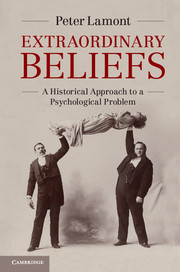Book contents
- Frontmatter
- Contents
- A brief reflexive preface
- Acknowledgements
- ONE Introduction
- TWO The making of the extraordinary
- THREE The making of mesmeric phenomena
- Four The making of spiritualist phenomena
- FIVE The making of psychic phenomena
- SIX The making of paranormal phenomena
- SEVEN The making of extraordinary beliefs
- Notes
- Bibliography
- Index
FIVE - The making of psychic phenomena
Published online by Cambridge University Press: 05 April 2013
- Frontmatter
- Contents
- A brief reflexive preface
- Acknowledgements
- ONE Introduction
- TWO The making of the extraordinary
- THREE The making of mesmeric phenomena
- Four The making of spiritualist phenomena
- FIVE The making of psychic phenomena
- SIX The making of paranormal phenomena
- SEVEN The making of extraordinary beliefs
- Notes
- Bibliography
- Index
Summary
The birth of psychic phenomena
In 1871, Daniel Home sat in a room with some very respectable gentlemen scientists. William Crookes was a Fellow of the Royal Society, and William Huggins was its vice-president. In front of them, and three other observers, Home caused an accordion to float inside a cage, and altered the weight of a plank of wood, without (apparently) touching them. Unable to provide an ordinary explanation for what happened at these strange experiments, Crookes announced that he had discovered a ‘psychic’ force.
The meaning of the term ‘psychic’ was ambiguous, since no theory was attached to it; indeed, it did little more than frame the phenomena as natural rather than supernatural. Nevertheless, this was enough to place its investigation within the remit of science, which was fundamental to the meaning of psychic phenomena, and to psychical research since. It was, however, no less problematic than the attempt to frame earlier phenomena as compatible with science. Crookes may have been a Fellow of the Royal Society, the chemist who had discovered the element thallium and editor of the Quarterly Journal of Science, but such scientific credentials were not in themselves sufficient. Thus, from the moment that Crookes went public about his investigations into the phenomena of spiritualism, he made the case in ways that were designed to be convincing.
- Type
- Chapter
- Information
- Extraordinary BeliefsA Historical Approach to a Psychological Problem, pp. 166 - 197Publisher: Cambridge University PressPrint publication year: 2013



